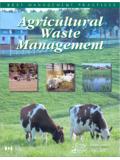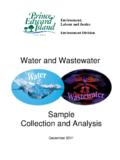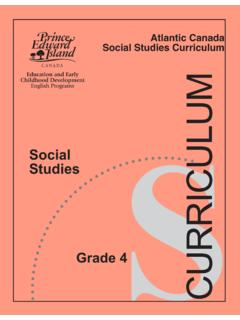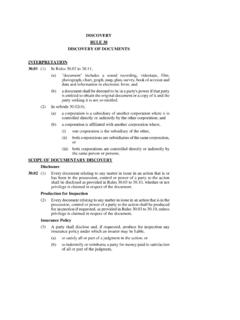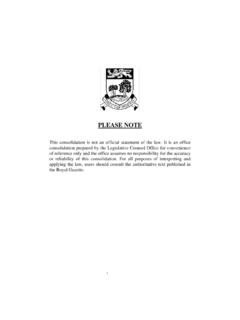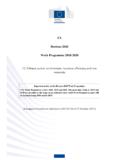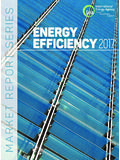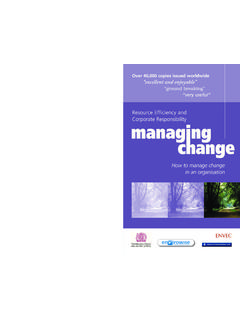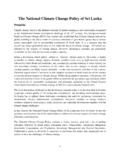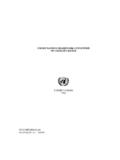Transcription of Prince Edward Island and Climate Change
1 O n e i s l a n d c o m m u n i t y o n e i s l a n d f u t u r eP r i n c e E d w a rd I s l a n d a n d C l i m a t e C h a n g eA S t r a t e g y f o r R e d u c i n g t h e I m p a c t s o f G l o b a l Wa r m i n gPrinted on recycled PaperSecuring our Future; PEI Environment and Energy Policy Series - Volume 1: Prince Edward Island Wind Energy Securing our Future: The 10 Point Plan - Volume 2: Prince Edward Island Energy Strategy Securing our Future: Energy, Conservation and Renewables - Volume 3: Prince Edward Island and Climate Change A Strategy for Reducing the Impacts of Global WarmingCopies of all reports available on our website: For more information contact: Department of Environment, Energy and Forestry Jones Building, 4th Floor 11 Kent Street, Charlottetown, PE, C1A 7N8 Telephone.
2 (902) INTRODUCTION 6 Background 6 Prince Edward Island s Action Plan for Managing Climate Change 6 Climate Change and Prince Edward Island 6 The Framework for Adaptation Policies 8 Consultation 9 Goals 9 Principles 9 Key Desired Outcomes 9 A History of Taking First Action on Climate Change 10 Setting Priorities 11 ENERGY EFFICIENCY AND CONSERVATION 12 Overview 12 The Potential 12 Office of Energy Efficiency 12 Building Code and Energy Standards 13 Energy Efficiency Advisory Committee RENEWABLE ENERGY 14 W ind 14 Role of Gover nment in Future W ind Development 15 Solar and Geothermal 15 Biomass and Biogas 16 Liquid Biofuels 17 Community-Based Renewable Energy Projects 19 TRANSPORTATION 20 Reducing Vehicle Emissions 20 Driver Education 22 Heavy Duty Vehicles 22 Vehicle Maintenance 23t a b l e o f c o n t e n t AGRICULTURE ADAPTATION 26 Climate Change Working Group 27 Light Detection and Ranging (LiDAR) Mapping 27 Land Use Planning 28 Environmental Impact Assessments 28 Climate Change Adaptation Priorities PUBLIC EDUCATION AND AWARENESS 30 Public School Education (K-12)
3 30 Prince Edward Island Centre for Climate Change Strategies GOVERNMENT LEADING BY EXAMPLE 32 Annual Climate Change Report 32 Green Building Policy for Gover nment Buildings 33 Energy Audits of Gover nment Facilities 33 Energy Technology Investment Fund 33 Environmental Procurement Policy 34 Transportation Efficiency Standard 34 Biofuel Procurement for Gover nment Facilities 35 Fuel Efficient Driving 35 Employee Awareness 35 Telecommuting and Compressed Work Week 35 Employee Transit Pass Program 36 Funding Climate Change Initiatives THE PATH FORWARD 38t a b l e o f c o n t e n t s6P r i n c e E d w a r d I s l a n d a n d C l i m a t e C h a n g ea s t r a t e g y f o r r e d u c i n g t h e i m p a c t s o f G l o b a l W a r m i n gP r i n c e E d w a rd I s l a n d s A c t i o n P l a n f o r M a n a g i n g C l i m a t e C h a n g e Prince Edward Island must develop resilient re-sponses to the unavoidable effects of Climate Change on its provincial infrastructure, natural habitats, resources and economy.
4 Reducing vulnerability to Climate Change through adap-tation efforts are essential. Government s role is to promote adaptation through immediate policy guidance, strong support and leadership by example. Prince Edward Island s Climate Change strategy builds on its existing efforts to reduce greenhouse gas emissions and adapt to meet the challenges of a world that has a more variable and less predictable l i m a t e C h a n g e a n d P r i n c e E d w a rd I s l a n dif the forecast trend in Climate disruption con-tinues, we can expect difficult times on Prince Edward Island . this despite the fact that Prince Edward Island is a low emitter of greenhouse gases, producing only of the nation s greenhouse gas emissions (co2 e3).
5 No substantial growth in greenhouse gas emis-sions has been experienced or is expected in Prince Edward Island over the next decade. unfortunately, as an Island with a highly erod-ible sandstone bedrock, an indented sandy shoreline with many estuaries and marshes, and the ongoing submergence of its coast, Prince Edward Island has been identified as one of the areas most vulnerable to sea level rise in a c k g ro u n d Climate Change is the Change in the long-term weather patterns experienced in a region. Human activities have resulted in the increased levels of heat-trapping gases which contribute to the warming of the Earth. 1in 2007 the intergovernmental Panel on Climate Change provided the most authoritative scientific information so far on Climate Change .
6 Key findings from their fourth assessment report 2 included the following observations: it is highly probable that the observed increase in globally averaged temperatures and increase in greenhouse gas concentrations is largely due to human activity, Warming of the Climate system is happening, Since records began (1850), 11 of the last 12 years (1995-2006) have ranked among the 12 warmest in the record of global surface temperatures, Global average sea levels have risen approximately 17 cm during the 20th century, and The warming of the world s seas and the rise in sea level has increased rapidly over the last n t r o d u c t i o n1 : Prince Edward Island Climate Change Consultation Document Draft.
7 June : Alley, R, Berntsen, T, Bindoff, NL, Chen, Z, Chidthaisong, A, Friedlingstein, P, Gregory, J, Hegerl, G, Heimann, M,Hewitson, B, Hoskins, B, Joos, F, Jouzel, J, Kattsov, V, Lohmann, U, Manning, M, Matsuno, T, Molina, M,Nicholls, N, Overpeck, J, Qin, D, Raga, G, Ramaswamy, V, Ren, J, Rusticucci, M, Solomon, S, Somerville, R,Stocker, TF, Stott, P, Stouffer, RJ, Whetton, P, Wood, RA & Wratt, D 2007, Climate Change 2007:The Physical Science Basis. Summary for Policymakers, Intergovernmental Panel on Climate Change ,Paris, viewed 5 February 2007, : CO2 e = The unit of measurement that defines the global warming potential of the six greenhouse gases. CO2 e is expressed in terms of the global warming potential of one unit of carbon dioxide.
8 Expressing all greenhouse gases in terms of tonnes of CO2 e allows the different gases to be grouped r i n c e E d w a r d I s l a n d a n d C l i m a t e C h a n g ea s t r a t e g y f o r r e d u c i n g t h e i m p a c t s o f G l o b a l W a r m i n gthe province is at significant risk from the negative effects of Climate Change , and has a considerable stake in national and international initiatives to limit greenhouse gas Climate warming will not only affect the Island s natural environment, it will also influ-ence islanders health and safety, impact their economic prosperity and affect their quality of life. While Prince Edward Island s Climate has been moderated by the influence of the Gulf of st.
9 Lawrence and the atlantic ocean s Gulf stream, in the last 10 years average temperatures in the province have been the warmest on record. sea level has risen over 30 centimetres since 1911, and the frequency and severity of hur-ricanes and storm surges have increased no-ticeably. Health problems associated with air pollution may become more common and we are already dealing with a prevalence of asthma and chronic respiratory diseases higher than the canadian average. natural resources canada identifies the follow-ing potential impacts in the atlantic region: an increase in storm events, increasing storm intensity, rising sea level, storm surges, coastal erosion, sediment redistribution, coastal sedimentation and flooding increased precipitation extremes, shifts in water tables, excessive moisture or drought, and less winter snow cover shifts in the winter ranges, distribution and breeding success of birds milder winters, early extended thaws, late springs, and early frosts higher temperatures and longer growing seasons that may benefit agriculture and forestry, but will also bring water resources under pressure, adversely affecting municipal water supplies, plac-ing stress on forest species that prefer cooler and wetter climates.
10 And impact the management of agricultural production and farm water usage, and loss of fish species as fish habitats Change and new fish distribution and migration patterns temperatures rise, new pest and disease problems are developing, affecting both the productivity of our crops and the health and biodiversity of our rivers and coastal waters. Water-borne contamination has become more prevalent, negatively affecting the value of our food products. rising sea levels and increased incidence of storm surge activity have affected shoreline stability, damaging property and dis-rupting sensitive ecosystems. longer periods without timely rain will increase the susceptibil-ity of forests to fires.
